An Introduction to the Contemporary Paintings in Assam with a reference to its Old Tradition
– Samiran Boruah
“Any path is only a path, and there is no affront, to oneself or to others, in dropping it if that is what your heart tells you……..Look at every path closely and deliberately. Try it as many times as you think necessary. Then ask yourself, and yourself alone one question……Does this path have a heart ? If it does, the path is good ; if it doesn’t it is of no use.
Carlos Castaneda” – The Teaching of Don Juan
The world of painting is of infinite varieties. Our abstract system of conceptual thinking can never judge its value adequately. The special kind of gratification we experienced from that world cannot be reduced to language, which is only an abstract generalization of the infinite varieties and qualities of the multidimensional world into a linear pattern of abstract symbols- the words. The artistic gratification is empirical by nature. If we try to understand and express it conceptually there is a danger of getting into confusion and misunderstanding. So at the outset I would like to remind the readers about the limitation of language in its description and Judgement, particularly when it deals with painting.
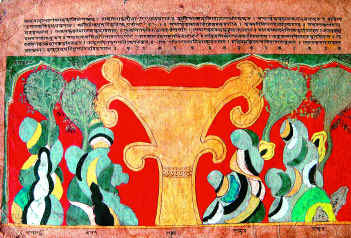
Before going into the discussion of the contemporary painting in Assam, a glimpse of the background of its tradition, I believe, will help the readers to apprehend the situation.
The tradition of painting in Assam goes far back and can be extended to the Puranic time. Of course the evidence of that tradition is only obtainable from a legend. In that beautiful legend a lady, named Chitralekha, was endowed with a great talent in portrait-painting.
We get the earliest literary evidence in Banabhatta’s Harsa Charita where mention has been made of the gifts from Bhaskarvarman, the king of Kamarupa of 7th century to Harshavardhana. The gifts include coloured or painted cloth in the pattern of Jasmine flower, and carved boxes for painting, and brushes. The Kalikapurana also mentions about decorated cloth which were used for offering to the deity. In the Babruvahana Parva of Harivar Vipra (14th cent.) we get reference of the paintings on walls.
Besides these, we have in our possession three historical relics which I consider as the earliest evidences of the art of drawing in his region. These are of course rock engravings. At Umatumoni, near Biswanath, on a huge boulder some engraved drawings of animals and geometrical designs have been noticed. It is also clearly visible from the style of these drawings that they belong to two distinctly separate phases. The style of the earliest phase consisting of the drawing of birds and animals, reminds us of primitive rock art, discovered in the different parts of the world. But besides the style, we do not have any other material evidences to ascertain the date of these drawings.
The other two we get in two cut-out slabs of stone collected from Lanka and Davaka respectively, now preserved in the Assam State Museum. In the first slab, below some scripts there is the drawing of a peculiar animal, perhaps a donkey over another animal, probably a pig, engraved in lines. Unfortunately the script has not been deciphered so far, which might have revealed the age of that drawing. On the other stone there are some human and animal figures which are also engraved in lines. Then until the 16th century, we do not have any other material evidence of this tradition’s continuations.
With the rise of the Neo-Vaisnavism under Sankar Deva, from 16th century onwards, we get a host of concrete examples that can be called painting in its real sense, that flourished until the last part of the 19th century. These polychrome paintings, popularly known as manuscript painting, done on sanchi pat or tulapat, were the illustrations of the stories of the Bhagavata, the Puranas, the Ramayana, the Mahabharata, etc., which contained written descriptions along with these paintings. At least one hundred manuscripts, each containing on an average forty such paintings, have been discovered so far.
From these paintings, it is apparent that both their form and spirit are traditionally integrated with the basic aesthetic concept of the Indian painting tradition. For example in almost all these paintings the Hindu spirit of religious fervour is clearly visible. Though in the later period the Mughal influence became evident, yet it had been able like the Rajasthani and Pahari School to synthesize that influence to its own advantage, and thus had been able to maintain its distinct regional entity. That is why we find the similarity of Assamese manuscript paintings to be more striking with the Kangra School than with the Mughal School. In the paintings of the manuscript of the first book of Brahmaavaivarta Purana which is now prescribed in the British Library, London, the Shankhachuda Vadha, the Hastividyarnava (of Auniati Satra), Kumara Harana (of both Budhbari and Dichial Satras), we experience the highest manifestation of this assimilation. On the other hand, in the paintings of the Chitra Bhagavata we experience something very original in its vigorous lines, contrast of colours and uniqueness of composition, which very well establishes its distinct identity.
However, in all the above mentioned paintings we feel the same confident and effortless control of the painter over his job that reflected in the vigorous lines, arrangement of space and choice of colours. In his expert hands even the otherwise irrational and awkward arrangement of space become normal, perfect and pleasing. There is also a separate genre of paintings where, instead of trained, expert and confident hand we encounter the lines of confusion and simplicity of a child, where colours and composition also become arbitrary and irrational. But this irrationality often opens up a vista for a kind of innocent pleasure of fantasy which the rational thinking always fails.
Until the later part of the 19th century, i.e. for some years even after the occupation of this territory by the British, this tradition continued. But due to the changing social and economic situation brought about by the British occupation, the tradition started losing its vigour gradually. Finally, it became dead and forgotten in the wooden boxes in the Namghars and Satras, to be discovered many years later by the historians and antiquaries of the 20th century. But by this time the spirit of this tradition had completely evaporated in the new social and cultural context without leaving any inheritors.
So, at last, when in the thirties of this century, after such a long stretch of time, the painters again started their works they created some strange paintings, unique in both their form and content. These painters had accepted the new idioms of culture that invaded the land in the wake of the British. The painting, hitherto an integral part of religion, resurrected itself in the western art institution and academy with an independent entity. Under the influence of this concept, there emerged three Assamese painters during the thirties. They were Mukta Bardoloi, Pratap Barua and Suren Bardoloi. So, instead of becoming the harbingers of modern sensibility for the extinct Assamese painting tradition, they became the disinherited sons of that tradition, who had to toil hard to build up a totally new structure, with whatever materials they received from the Western academic influences, over the demolished tradition. These painters used oil and their work also bore the unmistakable influence of Ravi Varma. The subject-matter of their paintings included still-life, landscape, portraits, rural life etc. The portraits of Radha Kanta Handique painted by Suren Bardoloi, is perhaps the best product of this period.
With the beginning of the forties, Tarun Duwara and Asu Dev had made their first appearance on the scene. In Tarun Duwara’s paintings, which are mainly the portrayal of rural life in the style of the early impressionists, we experience the melancholy of a banished man the memories of whose distant native village haunts him forever and ever. His ‘Weaver’ is not merely a documentation of a lost rural life, it is something more than that. It fills our hearts with nostalgia, compassion and a strange tragic sensation. In Asu Dev’s paintings, where the entire canvas is covered with coloured dots, we feel a distant reminiscence of Senrat. The theme of his painting has always been the landscape and rural life of this region. In some of his beautiful landscape paintings he is successful in portraying with an intense feeling the vigorous spirit of nature.
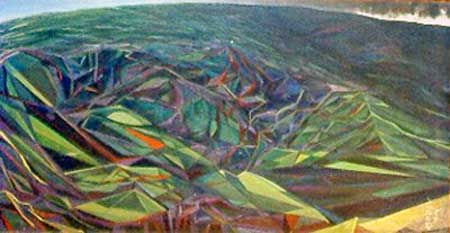
The most important event of this period was the establishment of the art school in the year 1947. Jibeswar Barua, on whose initiative and devotion the school was established, practically took all its burden on his own shoulder. Without Barua, who himself was a painter, the art school would not have come up so early and so easily.
Sobha Brahma and Benu Mishra made their appearance during the fifties. Sobha Brahma can undoubtedly claim the highest position in terms of quantity. In his painting the figures of his vast canvases always give us a feeling of monumentality. Often these figures seem to be in tension to release themselves from the space that surrounds and holds them. The vast area of his paintings is generally covered with gloomy colours, where suddenly appears a patch of contrasting vibrant colour giving a terrible jerk to the viewers. The use of metaphor in his painting proves his dexterity. But sometimes the metaphors become so overlapping that the painting becomes chaotic.
Benu Mishra, whose arrival had been welcomed by all art-lovers with great hope and expectation, had indeed produced some interesting paintings in his earlier career. But unfortunately he seems to have lost some of the earlier vigour and dexterity with the lapse of time. The portrait of Hiren Bhattacharya, which he has painted during his early period is the finest example of the painter’s inner turmoil that has manifested itself in the strong facial expression of the portrait.
The beginning of the sixties is marked by the arrival of four promising painters. They are Pranab Barua, Gauri Barman, Pulok Gogoi and Neelpavan Barua. In Pranab Barua’s painting we become aware of the painter’s strong foundation and determined control over his medium. The freshness of his colour always seems to radiate fresh air to its surroundings. Though his subject-matter mainly consists of the day-to-day life of the common folk, the portrayal of human faces turn out to be his most formidable plus point, where his dexterity and control over medium reaches the highest point of perfection. Gauri Barman’s painting is marked by its thick rigid lines and bright contrasting colours. Designs and decoration elements play an important role in his painting. In his latest paintings on birds, the decorative element plays the most dominating role. Pulok Gogoi’s paintings are characterised by their broken lines and flat colours. Though the lines are broken, nevertheless they are rhythmic which gives the painting a dynamic character. Some of Neelpavan Barua’s paintings are very strange and reveal the subtle sensibility of the painter. Whenever he tries to make a dialogue with nature, his paintings become very much organic, deeply immersed in love and compassion. But when he tries to depict human and animal farms in large Canvas, the whole thing becomes rigid and lifeless. However, in some of his very smaller canvases he painted some very pleasant paintings. In Neelpavan Barua’s paintings, also we observe a strong design and decorative character. We can also include Rajeswar Sharma to this group of painters, whose paintings are mostly predominated by a subtle lyrical quality. We always find his paintings surrounded by a mystic flavour.
The beginning of the seventies is an important era and is marked by the emergence of a good number of painters. Much activity also has been noticed during this period which is generated around two art organisations, i.e. The Assam Fine Arts & Crafts Society and Gawahati Artists’ Guild. Tapan Bardoli, Kandarpa Sharma, Jnanendra Barkakoti, Noni Barpujari, Rajen Hazarika, Aminul Haque, Dhruba Deka, Bhupendra Nath Bhattacharya, Naren Das, Pranab Barua (Jorhat) are the painters who belong to this period. The writer of this article also belongs to this group. The works of all these painters are figurative except in the case of a very few whose works are non-figurative. The figures of almost all these painters, however, seem to be stagnant, lacking in the vigour, both in farm and spirit. However, occasionally we observe a vigorous evolutionary dynamism both in form and spirit in some of the painters, in which the departure from the exhausted age-old idioms is clearly discernible. In these painters we became aware of their endeavour to give a new meaning to the farms, metaphorically. The non-figurative paintings of this period which are very few in numbers are mainly composed of juxtaposition of pure flat colours. So far nobody has paid any attention to the possibilities of non-representational concrete forms.
The painters who have entered the scene during the eighties, all without exception come from the formal art institution. It may be mentioned here that the majority of the former artists’ do not have any formal art education. Among the newcomers we can mention the name of Utpal Barua and Dilip Tamuly who show the promises. Utpal Barua’s cool harmonious colour fills the painting with calm serenity. But the man, animals and objects of his painting seem to stand there idly, without evoking any curiosity in the viewers. In Dilip Tamuly’s work we encounter the grotesque figures in a morbid environment depicted in forceful lines. Often his works look like a chaos.
Among the above mentioned painters Mukta Bardoloi, Pratap Baruah and Suren Bardoloi, Asu Dev and Rajen Hazarika are no longer in this world. And among the living some have almost left painting for different reasons. The remaining painters, mostly belonging to the younger generation now fill the contemporary scene. As they are mostly young, we have every reason to expect a much higher stage of perfection in their works.
Samiran Boruah is an associate of the Assam State Museum, Guwahati, India. The author is working on a digital archive of miniature paintings of Assamese manuscripts with financial support from the India Foundation for the Arts, Bangalore, India (www.indiaifa.org). This archive will be available for the public shortly at the Assam State Museum, Guwahati, Assam, India. Website: www.samiran-boruah.odexpo.com/
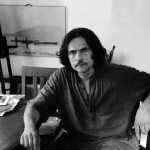
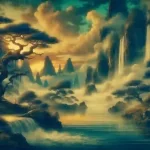

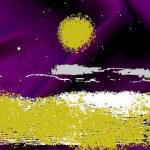
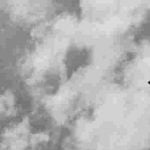
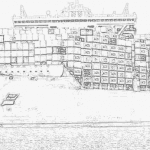
Leave a Reply